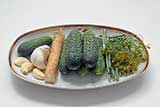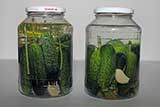Meats and Sausages
Fermented Cucumbers
Fermented cucumbers are made from small hard cucumbers, mature dill, horseradish and salty water. Pack all ingredients tight in a jar so they will be fully covered in brine and the rest is easy.
You can vary the amount of salt in brine:
- Low-salt cucumbers: 30 g (1.05 oz = 5 tsp) salt to 1 liter (just over a quart) of water.
- Regular-salt cucumbers: 40 g (1.41 oz = 7 tsp) salt to 1 liter (just over a quart) of water.
Depending on your preference, fermented cucumbers are ready to consume in 3-4 days or wait longer for more acidic taste. Naturally fermented cucumbers are made without vinegar and are meant to be consumed in a relatively short time. When desired acidity is obtained, place jar in refrigerator to stop fermentation. Many people like to drink cucumber juice which is quite delicious. Naturally fermented cucumbers have little in common with loaded with vinegar commercial product.
Materials
- Cucumbers, fermenting variety. Those are small hard cucumbers with little spikes.
- Garlic.
- Mature dill – use flowers and stems. Don’t confuse with bunches of young green sprigs of dill which are sold in supermarkets. Young dill often rots in brine. It is the same variety, but you need mature blooming plant which is 2-3 feet tall.
- Horseradish root.
Instructions
Wash cucumbers, scrape the ends with fingernail. Those areas contain most of bacteria. Some people cut the end off, but there is no need for that.
Peel off garlic and horseradish. Cut up horseradish and dill.
Place dill on the bottom, then fit cucumbers vertically as tight as possible. Fit garlic and dill stems into open spaces.
Mix salt with water and fill the jar with brine. If cucumbers are packed tight they will be completely submerged in brine.
Ferment at room temperature. They will be ready to eat in 3 days.



















